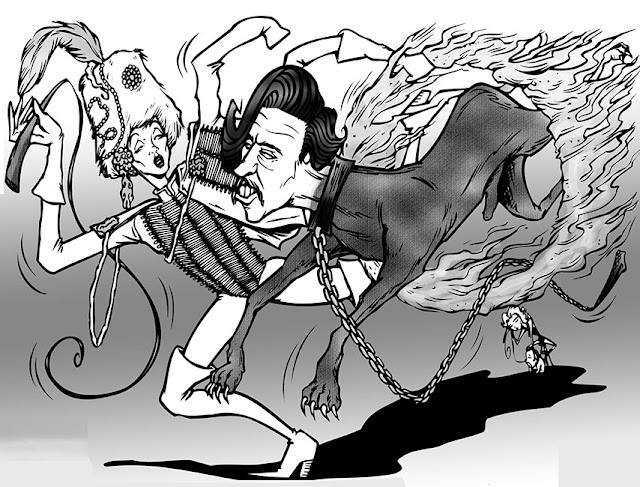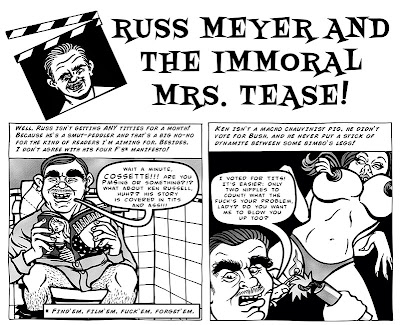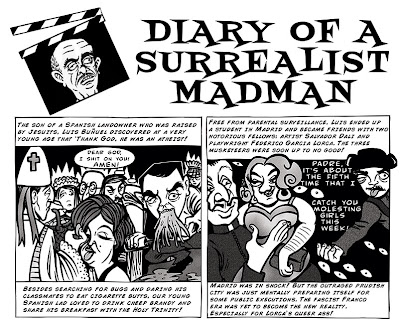In his 1890 novel, ‘The Picture of Dorian Gray’, Oscar
Wilde tells the story of a young man who sells his soul in exchange for eternal
youth. A creepy and frightening painting ages in his place and exposes the
man’s sick soul. Dorian is vain, mean, self-centered, and lives a life of
debauchery. So what does that have to do with Madonna? Well, I see a strong
parallel. The youthful version of Madonna was blessed with stunning beauty when
she came to fame in the ‘80s. Now in middle age, she’s still unapologetically vain
and will do anything to continue
looking young and hot, and if that means going under the scalpel, so be it. Sure,
that doesn’t make Madonna very different from other aging stars, but the
Material Girl, er, Lady, is also
known to be an ultra-bitch when interviewed, and debauchery remains her middle
name, or so that’s what she’d like us to believe.

As she’s gets older, Madonna reminds me of the raunchy 1930s
movie star Mae West who, by the time she was 80, surrounded herself with young
muscular boy-toys in diapers. West was desperate to stay in the spotlight
without being regarded as an ageing has-been. Fifty-five year old Madonna not only
kind of looks like her, she also has a potty mouth like Mae, although West was
way wittier. And as she holds on to her sex symbol crown for dear life, she even
acts like her. All Madonna needs to do now is promote the joy of enemas to seal
the deal!
But before mimicking Mae West, Madonna was very much
trying to follow in the high-heeled footsteps of Marlene Dietrich who was the sex goddess of the Silver Screen in
the Dirty Thirties. Dietrich, as Madonna did decades later, got involved with a
famous filmmaker. Both very dominant women and iconic spotlight grabbers, the similarities
between them gave me the devious idea for a symbolically funny story for my
book, Sinemania!
In my story, “Love at First Bark”, Madonna and Marlene compete
to win first prize at a… dog show! The two divas bitch and brag non-stop about
who’s ‘best in show’ while recalling their experiences with their magnificent pets’
prowess. I won’t tell you more, except to say that the competition is fierce!
The eccentric Josef von Sternberg, or ‘Joe the Great
Dane’ as I drew him in “Love at First Bark”, was one of the finest filmmakers
of Hollywood’s Golden Age. His over- budget extravaganzas with their over-the-top
sets were often compared to the movies of his fellow Viennese Jew, Erich von
Stroheim, who by the way, was his hero. Von Sternberg did six movies with
Marlene Dietrich and they’ll forever be linked as lovers and cinematic legends.
He discovered Dietrich, a young -married mother of a little
girl, and made her a huge star when he cast her as Lola Lola in his 1930 film ‘The
Blue Angel’. They became romantically involved and moved to the U.S. where they
made five other flicks together. Dietrich had an open marriage, staying with
her husband during her liaison with von Sternberg. She enjoyed having rumors of
bisexuality follow her around, just for the fun of spicing things up. (Wait,
didn’t Madonna do that, too?) Strangely enough, Dietrich had the reputation of
seeing other women as rivals, even claiming that she despised being in their
company because “what all women do is count your wrinkles!” Maybe she had never
heard of the psychological term ‘projection’, but let me get back to von
Sternberg’s work…

His 1934 film, ‘The Scarlet Empress’, was very far-out and
scandalous for its time. The cinematography and décor in it are just mind
blowing! Check out this trailer featuring grotesque sculptures in the
background, and enjoy some delirious Russian decadence while you’re at it.
By the following year, the relationship between Dietrich
and von Sternberg began to deteriorate. Marlene loved to seduce everything that
moved. The scandal around ‘The Scarlet Empress’ and the studio favoring her stardom
over his didn’t help matters. It was like something out of ‘A Star is Born’: a
bad tango of inflated egos was about to finish in blood and tears…
The last movie the director and his sexy star did together
was ‘The Devil is a Woman’. That title symbolized their toxic relationship perfectly
and the film was the final nail in their coffin. The atmosphere on the set was
like a bullfight, with von Sternberg the dead matador who saw his own career
disappearing into dust, miserably witnessing his muse Marlene reach the top and
stay there without him.
But the story of two super egos’ destructively combusting
like oil on fire is an eternal one. Which brings me to Madonna and filmmaker
Guy Ritchie A.K.A. ‘Guy the English Bulldog’ in my “Love at First Bark” story. She
was introduced to him by some mutual friends and like Madonna, Ritchie was
cocky, elitist, successful, good-looking, attention-seeking, and very
ambitious.
His excellent and acclaimed 1998 film, ‘Lock, Stock and Two
Smoking Barrels’ put him on the map as a new talent to watch for and sure
enough, Madonna took note of him.
They teamed up for a few projects, the most enjoyable of
which by far was Ritchie’s BMW commercial in which Madonna plays herself
(although I’m not sure if she’s spoofing herself or not). If you’ve never seen
this ad, here it is for your entertainment.
Ritchie also directed one of her music videos and
unfortunately gave her the starring role in his poorly inspired remake of a
1974 Italian film, ‘Swept Away’. But after a lavish wedding, a son, an adopted
kid, and the co-ownership of a London pub serving overpriced beers, the superstar
couple’s honeymoon was over. Ritchie would complain that he’d have to make an
appointment to have sex with her. Madonna, in turn, lamented that he was
insensitive towards her after she broke many bones in a horse riding accident, brushing
it off by telling her, “You’re a tough girl, you can handle it!”
Guy Ritchie was right: Lady Madonna is a tough cookie. After a very costly divorce, she went back to
her old ways by adopting interchangeable ‘puppy dancers’ as boy-toys and
becoming a movie director herself. Her first filmmaking attempt was 2008’s
‘Filth and Wisdom’, a dark comedy about struggling youngsters in London. The
critics trashed the movie and it was poorly distributed. I’ve never actually
seen it, but you can watch this trailer for a little glimpse.
If you’re not impressed with the contents of that
trailer, here’s how I’d imagine Madonna might respond…
The critics consider her to be a dreadful director and
actress. Like Frank Sinatra (who, mind you, could be a hell of an actor),
Madonna insists on doing only one take in front of the cameras. Convinced that
she’s always right and cocksure of her talents, she has the reputation of being
an ultra-perfectionist, but that doesn’t apply to her acting, bizarrely enough.
Madonna’s also known to be a very strict control freak mom
and her extravagant demands to hotels when she travels around the world with
her crew are insane!
The media and gossip websites take immense perverse pleasure
in reflecting Madonna’s nasty aging image back to her. The fact that the world is
watching must be a sore spot for the superstar since it regularly focuses on
her veiny arms and hands (she wears gloves now), swollen plastic surgery-ridden
face, and extremely narcissistic behavior. Until she does a Greta Garbo-style
vanishing act, that’s the price Madonna’s got to pay for her ongoing fame.
Well, it’s obvious by now that I don’t admire the woman.
Then why did I bother writing and illustrating a story on her? Frankly, I found
her impossible to resist! Thanks to her huge ego and ‘my shit don’t stink’
attitude’, Madonna’s painfully colorful and irrationally strange to me. Yes, the
‘woman I love to hate’ makes me cringe and reminds me of everything bad about
the ’80s: superficiality, the ‘greed is good’ philosophy, the obsession with
having a perfect body (thanks to you too, Jane Fonda!), hyper-materialism, and the
growing division between rich and poor that’s reached epidemic proportions
nowadays. To me, she symbolizes all that.
This is my
picture of Madonna Gray and I hope it won’t you give nightmares. So, sweet dreams and goodnight for now!

















































